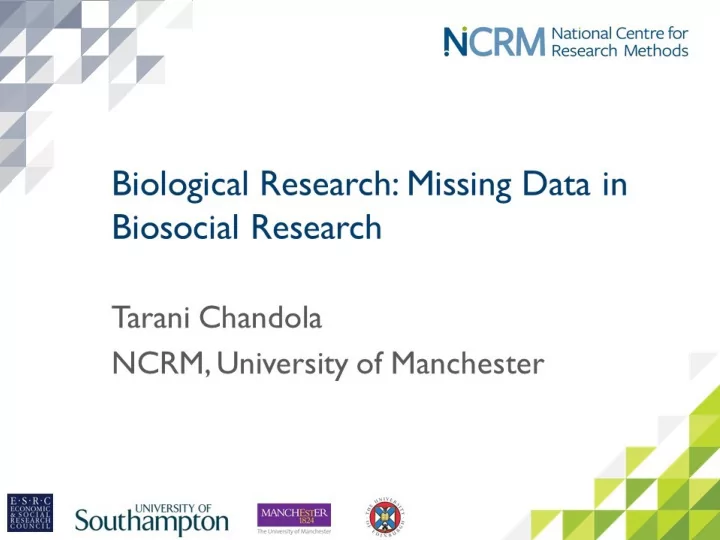

Methodological considerations • Biosocial research framework • Biological data quality issues • Missing data in biosocial research
Missing biological data • Substantial proportions of missing biological data • A number of processes that could result in missing biological data in biosocial surveys – No main interview – Main interview but no nurse visit – Nurse visit but no blood sample – Blood sample but no blood analytes
Blood sampling outcome in UKHLS- wave 2 blood sampling outcome- UKHLS wave 2 Freq. Percent blood sample obtained 13021 64% blood sample not obtained 1412 6.9% refused blood sample or nurse 4271 21.0% ineligible for blood sample 1570 7.7% blood sample lost in transit 81 0.4%
Use survey data for correlates of missing biological data Detailed survey information on participants Standard practice for biological data collectors (usually nurses) to record reasons for missing biological samples. These data can be useful in informing us about the reasons for missing biological samples.
Typical variables included in developing non-response weights • Sample month/quarter • Region or other geographical aggregates of postcode sectors • Deprivation indices (IMD, Townsend, Carstairs) and other geographically-referenced indicators • Interviewer observation variables regarding the dwelling and immediate surroundings • Social, demographic and economic indicators from the household and individual questionnaires
English Longitudinal Study of Ageing (ELSA)- wave 6 hair analytes • At wave 6, ELSA hair samples were collected for the first time. • From the hair samples, hair analytes such as cortisol were processed. Hair cortisol is an integrated measure of Hypothalamic-Pituitary-Axis (HPA) axis activity, with higher levels indicating higher physiological stress responses. • Around 2 cm of hair were collected, which is indicative of stress levels over the last 2-3 months.
ELSA Hair Sample Protocol In order to measure Cortisol in a hair sample, the sample needs to be a minimum of 2cms in length and weigh a minimum of 10mg. http://www.elsa-project.ac.uk/uploads/elsa/docs_w6/hair_sample_card.pdf
ELSA Hair Sample Protocol The hair sample should be taken from an area on the back of the head, indicated by the yellow circles on the pictures
ELSA wave 6- missing hair cortisol data • Out of 7,419 ELSA participants in the nurse data collection, there were only 2,558 participants with hair cortisol data. • This is partly because some people were ineligible for the data collection (having less than 2 cm of hair). • Others refused to give hair samples, mainly for reasons related to appearance. • And funding constraints meant that only a subset of the hair samples could be processed to produce hair cortisol data.
Possible characteristics of ELSA participants with missing hair data • Baldness predominantly affects men and older adults • Given the importance of appearance to some participants, it is likely that having a negative self-image is linked to missing hair cortisol data. • ELSA survey asks detailed questions related to depressive symptoms (the CESD questionnaire) • As stress and depression are interlinked, depressive symptoms may predict both missing hair cortisol data as well as higher levels of hair cortisol.
Predicted probability of missing hair cortisol data by age/gender and depressive symptoms age/gender interaction Depressive symptoms 0.5 0.5 predicted prob of hair cortisol sample predicted prob of hair cortisol sample 0.45 0.45 0.4 0.4 0.35 0.35 0.3 0.3 Women 0.25 0.25 CESD Depressive symptoms score Men 0.2 0.2 0.15 0.15 0.1 0.1 0.05 0.05 0 0 under 60 60-64 65-69 70-74 75-79 over 80 Less than 4 4 or more
Differences in complete case and weighted regression estimates of (log) hair cortisol by depressive symptoms 3 2.5 predicted hair (log) cortisol 2 1.5 CESD score less than 4 CESD score 4 or more 1 0.5 0 complete case weighted analyses
Missing biosocial data: methodological considerations • Rich survey and nurse observation data allows us to discover factors that are both correlated with the missingness mechanism as well as our outcome of interest. • Inference based on complete case analyses may be biased if we don’t take account of such factors. • Need to investigate the reasons behind missing biological data and incorporate such information in their methods to deal with missing data.
Recap of methodological considerations • Biosocial research framework • Biological data quality issues • Missing data in biosocial research
Methodological considerations when analysing biosocial data • A biosocial theoretical framework is key • Consider: – normal ranges of biological variables (if available) – identify outliers – relevant medication use – context of blood sampling like time of day, room temperature, recent operations, smoking, food & alcohol, etc – quality control processes in producing biological data – transformations (for skewed biological dependent variables) • Identify relevant predictors of missing biological data to use in non-response methods from rich social/attitudinal data
Recommend
More recommend